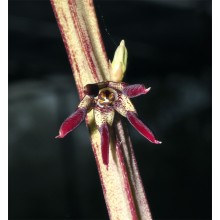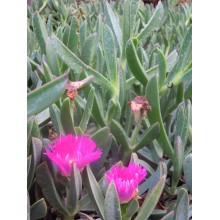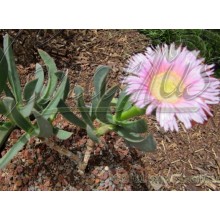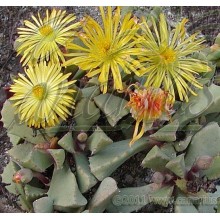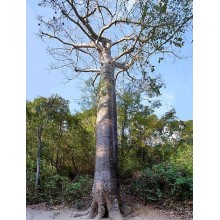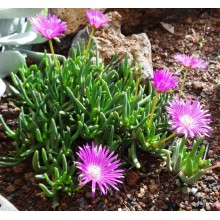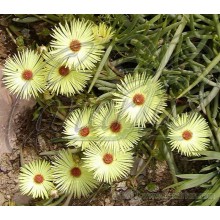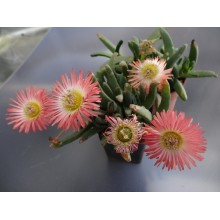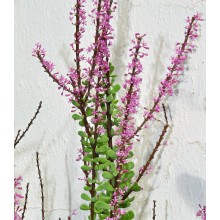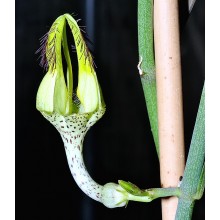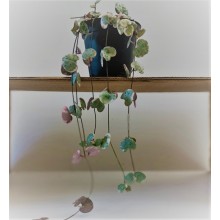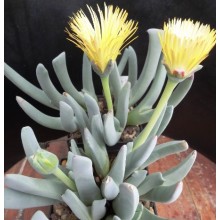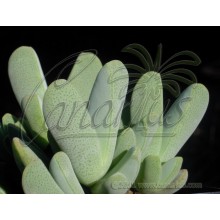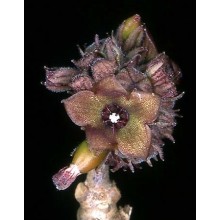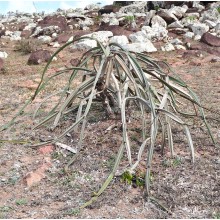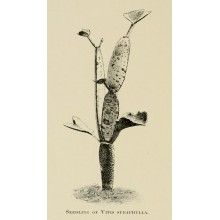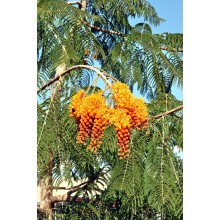Succulents There are 628 products.

World deserts and dry areas are home to the most interesting plants. Canarius offers an increasing selection of succulent plants of maximum quality, because they are grown outdoors, under the full sun of the Canary Islands.
Succulents or "fat plants" are water-retaining species, adapted to dry conditions. They store succum (juice, water) in their leaves, stems or roots, and often show a stout and fleshy appearance.
Subcategories
-
Agave
Agave is a genus of succulent plants from America. Some species grow in cold areas and take hard frost, while some others live in tropical climates. Some are tiny dwarfs and some are giants, up to 2 or 3 m wide.
Cold hardy agaves can create an exotic effect in your garden. Agave species make fine companions to palms or cacti. Variegated agaves are incredibly sought after by collectors. Our web shop offers an ever changing selection of species. We ship bare rooted plants, unless otherwise specified.
-
Aloe, Gasteria & Haworthia
Aloe, Gasteria and Haworthia are three related genera, comprising hundreds of succulent plants. They are all easily grown in pots. A few adapt to low-light levels of indoor conditions and can be grown as house plants.
- Aloe is a genus of about 400 species, native to Africa, Arabia and Madagascar. Small or dwarf aloes are becoming especially popular in colder climates as they can be taken indoors during the hardest months.
- Gasteria includes some 80 species endemic to South Africa, known for their spectacular leaves which are glossy, mottled and textured. They bloom in Spring-Summer with long spikes of small orange flowers. Some species are so variable that we offer particular clones from specific locations.
- Haworthia is a genus endemic to South Africa with about 70 species and a number of local subspecies, varieties and forms. Leaves are often banded, speckled, dotted, or semi-translucent and show wide variations.
-
Crassulaceae
This is a new, growing section of species from the family Crassulaceae. There are about 1,400 species in 33 genera and their distribution is worldwide, but mostly occur in the Northern Hemisphere and Southern Africa, especially in dry habitats. Here you can buy healthy, sun-hardened plants grown in the Canary Islands and shipped to your home.
-
Mesembs
This group of desert plants is briefly named Mesembs because they belong to a botanical family formerly named Mesembryanthemaceae. There are almost 2.000 species, mainly found in Southern Africa, with extreme adaptations to dry habitats. Some are called "living stones", as they look like pebbles. Many are easy to grow and their main need is full sun. Some are difficult because they grow in truly extreme areas.
Our Web Shop offers sun grown healthy plants, with compact and colourful leaves. Some plants are sold as cuttings, and others as rooted plants, of at least two years old.
-
Sansevieria
Recently assigned to the family Asparagaceae, the genus Sansevieria counts about 70 species, nearly all native to Africa, Arabia and Madagascar. Perennial herbs adapted to dry habitats with stiff, succulent leaves, their length ranges from a few centimeters to 2 meters. Sansevieria trifasciata and its many cultivars are among the most popular houseplants, popularly called mother in law's tongue. A well grown plant usually produces a spike of many white, richly scented flowers and then orange berries. Even the rarest species are resistant to neglect, provided you keep them from frost in winter and scorching sun in summer.
-
Hoya
Hoyas are twining vines, with showy exotic flowers, from the rainforests in Asia and Oceania. Most species grow in bright shade or morning sun, but they will also grow indoors as house plants. They are well suited for baskets, trellises or ladders. They tolerate a few weeks of drought but they are sensitive to frost and cold. Many hoyas are easy to grow and bloom, while some are tricky and rare.
-
Asclepiads
Asclepiads or Asclepiadoideae are a subfamily in the Apocynaceae, with about 2900 species. There are lots of leafless stem succulents but also perennial herbs, shrubs, lianas or rarely trees. They produce remarkable flowers, for the complex mechanisms they have developed for pollination. Many species produce an unusual fragrance, often called "carrion", and attracts flies for pollination. -
Caudiciforms
These plants from dry areas produce an unusually thick stem, the caudex. They are also called pachycauls and they have a disproportionately thick trunk, often with few branches. The caudex can be hidden underground, but in most cases they grow upwards, forming spectacular trees. The largest caudiciforms in the world are the baobabs. -
Other succulents
Here you will find all those species of desert plants that are not included in their own category. We will place here all plants from unusual families, other than Agaves, Aloes, Crassulaceae, Sansevieria, Mesembs, Epiphytic cacti, etc.
-
Caralluma adscendens var. Adscendens
Caralluma adscendens var. Adscendens
2 year old seedling
27,50 € -
Carpobrotus acinaciformis
Carpobrotus acinaciformis
Larger in all its parts, this ornamental creeping mesemb bears huge magenta flowers.
10,70 € -
Carpobrotus mellei
Carpobrotus mellei
Endemic to the inland mountains in the SW Cape ofS Africa. It easily blooms in pots and does not need to bein the ground. It is the only mountain Carpobrotus and does not need a coastal climate. Leaves contain natural antibi
11,90 € -
Carruanthus ringens
Carruanthus ringens
Branched plant, Cont.= 8,5 cm. Native to the Little Karoo in South Africa, this species in an opportunistic grower and can rest or grow in about any time of the year.
10,80 € -
Cavanillesia platanifolia
Cavanillesia platanifolia
In short words, this is the American Baobab. This American bottle tree is related to true baobabs of the genus Adansonia, which are only found in Africa, Madagascar and Australia: Cavanillesia also looks similar in habit because of its gigantic swollen trunk
78,60 € -
Cephalophyllum alstonii Pink Form
Cephalophyllum alstonii Pink Form
Pink flowered form of an easy, creeping species, often used as a ground cover. It has beautiful glaucous leaves, triangular in section. Abundant bright flowers in winter, spectacular. It grows wild in the Ceres Karoo in a winter rainfall area. Protect from heavy frost .
10,40 € -
Cephalophyllum pillansii
Cephalophyllum pillansii
Branched plant. Cont.= 6 cm. Mat-forming South African succulent with gray-green leaves. Flowers are beautiful, glossy light yellow with dark centers. It blooms in spring and often repeats in Summer.
10,70 € -
Cephalophyllum spissum
Cephalophyllum spissum
Pink flowered form of an easy, creeping species, often used as a ground cover. It has beautiful glaucous leaves, triangular in section. Abundant bright flowers in winter, spectacular. It grows wild in the Ceres Karoo in a winter rainfall area. Protect from heavy frost .
10,20 € -
Ceropegia ampliata
Ceropegia ampliata
Rare succulent twiner from South Africa. It produces groups of 2-4 large, exotic, unusual flowers, opening one after the other, about 6 cm long, pale green to white.
20,80 € -
Ceropegia juncea
Ceropegia juncea
Scrambling or climbing ceropegia from India with tuberous roots and almost leafless stems. Leaves are fleshy and diminute, sparsely distributed and lance-shaped. Flowers are large, lantern-shaped, lime-yellow in colour and nicely speckled in green and purple. They are also decorated by pink "hairs"!
36,80 € -
Ceropegia woodii variegata
Ceropegia woodii variegata
Ceropegia woodii is a flowering plant in the dogbane family Apocynaceae, native to South Africa, Eswatini and Zimbabwe. It is an evergreen succulent trailing vine that grows to 10 centimetres (3.9 in) in height and spreads to reach up to 2–4 metres (6 ft 7 in – 13 ft 1 in) in length.
38,50 € -
Cheiridopsis candidissima
Cheiridopsis candidissima
Cont.= 12 cm. Huge Plant with >8 heads. Beautiful plant from the Little Karoo, with large, greyish V-shaped leaves. With age, leaf tips form elegant teeth. Large cream to yellow flowers. Full sun to light shade. Keep drier in summer.
10,80 € -
Cheiridopsis purpurea
Cheiridopsis purpurea
NEW! - Branched plant, Cont.= 12 cm. Purple flowered compact mesemb, native to the Richtersveld in South Africa. It grows in full sun to light shade. Keep drier in Summer. Tolerant of light frost.
10,80 € -
Cibirhiza dhofarensis
Cibirhiza dhofarensis
1 year old seedling, caudex: about 1 cm. This slow and hard to find asclepiad is endemic to the region of Dhofar, in Oman. Its tuberous roots are edible, but we think our customers will never have one for lunch!
35,00 € -
Cissus hamaderohensis
Cissus hamaderohensis
Succulent shrub from upland Socotra. This Cissus has flat grey stems, they can be scrambling, creeping or even climbing. We offer a rooted cutting, with one ore more new growths.
27,50 € -
Cissus subaphylla
Cissus subaphylla
Succulent shrubby Cissus from the island of Socotra. Stems are flat, grey and succulent. It grows erect when young, while adult plants infull sun eventually form a dome-shaped shrub of perfectly interlocked stems.
32,50 €
At the moment there are few products in this category Succulents

























